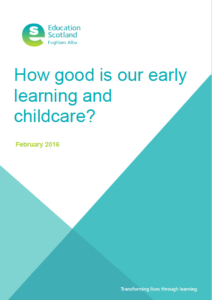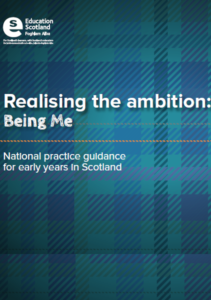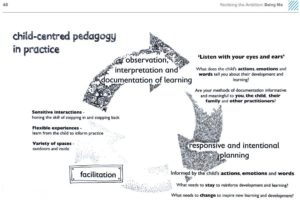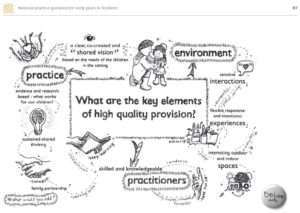Play
– Reflecting on Practice
QI 2.2 p 27
Challenge questions
In what ways do we share the purpose of our curriculum framework with children, parents, practitioners and partners? What difference does this make to our practice?
Are children regularly involved in evaluating their play experiences and can they describe what they are learning?
What do we do with this information?
What changes could we make to use this more effectively?
In our work with colleagues in other settings and sectors, to what extent do we focus on a shared understanding of continuity and progression in learning? What are the arrangements to share children’s learning across, for example, the early level of Curriculum for Excellence?
QI 2.3 p 29
To what extent do our learning environments support different types of play?
QI 3.2 p44
Reflect on the current balance of adult and child initiated learning experiences. Are both leading to progress? What could be improved?
QI 3.3 p 46
How well are natural materials and open-ended resources used to support sensory play, exploratory play and creativity?
In what ways and to what extent do children make choices and decisions about their play and learning?
QI 1.3 p21-23
Children have fun as they experience high quality play, learning and development opportunities
Children are empowered to be fully involved in their play and learning through the skilled interactions and actions of staff
Links to the Health and Social Care Standards
2.27 As a child, I can direct my own play and activities in the way that I choose, and freely access a wide range of experiences and resources suitable to my age and stage, which stimulate my natural curiosity, learning and creativity.
QI 2.1 p37-40
Children benefit from high quality play and learning settings.
Staff enable children to influence the design of the setting and the provision of appropriate resources and how they use them
Links to the Health and Social Care Standards
1.25 I can choose to have an active life and participate in a range of recreational, social, creative, physical and learning activities every day, both indoors and outdoors.
1.32 As a child, I play outdoors every day and regularly explore a natural environment.
2.24 I make informed choices and decisions about the risks I take in my daily life and am encouraged to take positive risks which enhance the quality of my life.
2.27 As a child, I can direct my own play and activities in the way that I choose, and freely access a wide range of experiences and resources suitable for my age and stage, which stimulate my natural curiosity, learning and creativity
QI 3.2 p53-55
High-quality play and learning culture is fully embedded
Children actively lead their play and learning.
Links to the Health and Social Care Standards
1.30 As a child, I have fun as I develop my skills in understanding, thinking, investigation and problem solving, including through imaginative play and storytelling.
2.27 As a child, I can direct my own play and activities in the way that I choose, and freely access a wide range of experiences and resources suitable for my age and stage, which stimulate my natural curiosity, learning and creativity
QI 2.2 p35 – Curriculum
Challenge questions
Does the curriculum experienced by our learners reflect our rationale? How do we know?
How well are children and young people involved in planning and identifying opportunities for personalisation and choice?
How well do our approaches to profiling develop children’s and young people’s awareness of themselves as learners and support them to recognise the skills for learning, life and work they are developing to inform the planning of future learning?





